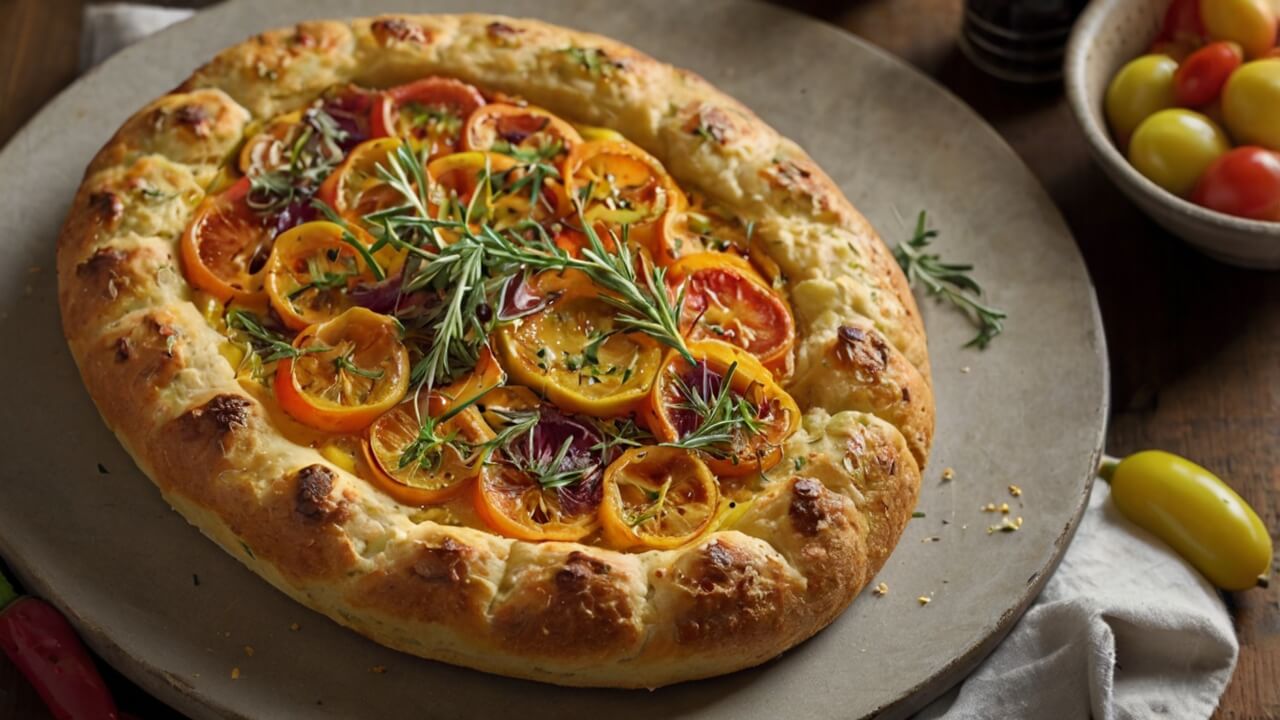Anne Burrell is a renowned American chef, television personality, and author, renowned for her vibrant personality and rustic yet refined culinary style.
With a passion for Italian cuisine instilled from her years spent studying in Italy, Burrell has become a household name, sharing her expertise through numerous cookbooks and appearances on popular shows like “Worst Cooks in America” and “Chef Wanted with Anne Burrell.”
One of Burrell’s signature recipes that has captured the hearts and taste buds of home bakers and food enthusiasts alike is her focaccia.
This classic Italian flatbread is a staple in her repertoire, showcasing her mastery of simple yet flavorful ingredients and techniques.
Burrell’s focaccia recipe stands out for its crispy, golden crust and pillowy soft interior, achieved through a generous use of high-quality olive oil and a meticulous proofing process.
What sets Burrell’s focaccia apart is her unwavering commitment to quality and her ability to transform humble ingredients into something extraordinary.
Her recipe is a testament to her culinary philosophy of celebrating the essence of each component, allowing the flavors to shine through without unnecessary embellishments.
The result is a focaccia that is not only delicious but also deeply satisfying, capturing the essence of Italian comfort food.
What Makes Anne Burrell’s Focaccia Unique?
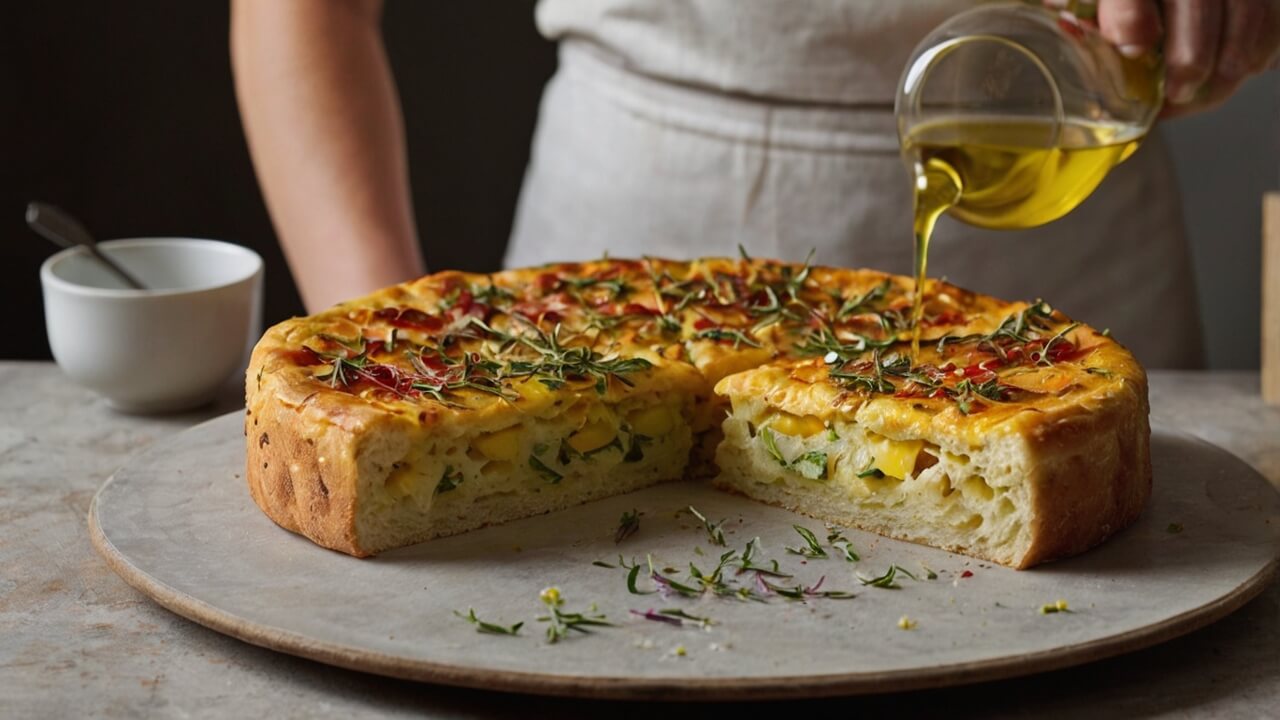
Anne Burrell’s focaccia recipe stands out for its distinctive use of olive oil, which creates a remarkably crispy crust and rich, flavorful interior.
Unlike many traditional focaccia recipes that call for a modest amount of olive oil, Burrell’s version incorporates a generous quantity, resulting in a bread that is both indulgent and deeply satisfying.
The liberal use of olive oil is evident from the very start, as the dough is mixed with a significant portion of the golden liquid.
This initial infusion ensures that every bite is imbued with the robust, fruity notes that high-quality olive oil imparts. As the dough rests and rises, the olive oil works its magic, creating a tender and moist crumb that melts in your mouth.
But it’s during the baking process that Burrell’s focaccia truly shines. Before transferring the dough to the oven, it is generously doused with even more olive oil, which seeps into every nook and cranny.
As the bread bakes, this excess oil creates a crispy, almost fried-like crust that shatters delightfully with each bite. The contrast between the crunchy exterior and the pillowy soft interior is a textural delight that sets this focaccia apart from others.
Burrell’s masterful use of olive oil doesn’t stop there. Once out of the oven, the hot focaccia is brushed with yet another layer of the golden liquid, ensuring that every inch of the bread is infused with its rich, robust flavor.
This final touch elevates the focaccia to new heights, making it a true celebration of one of the most beloved ingredients in Italian cuisine.
Ingredients and Tools Needed
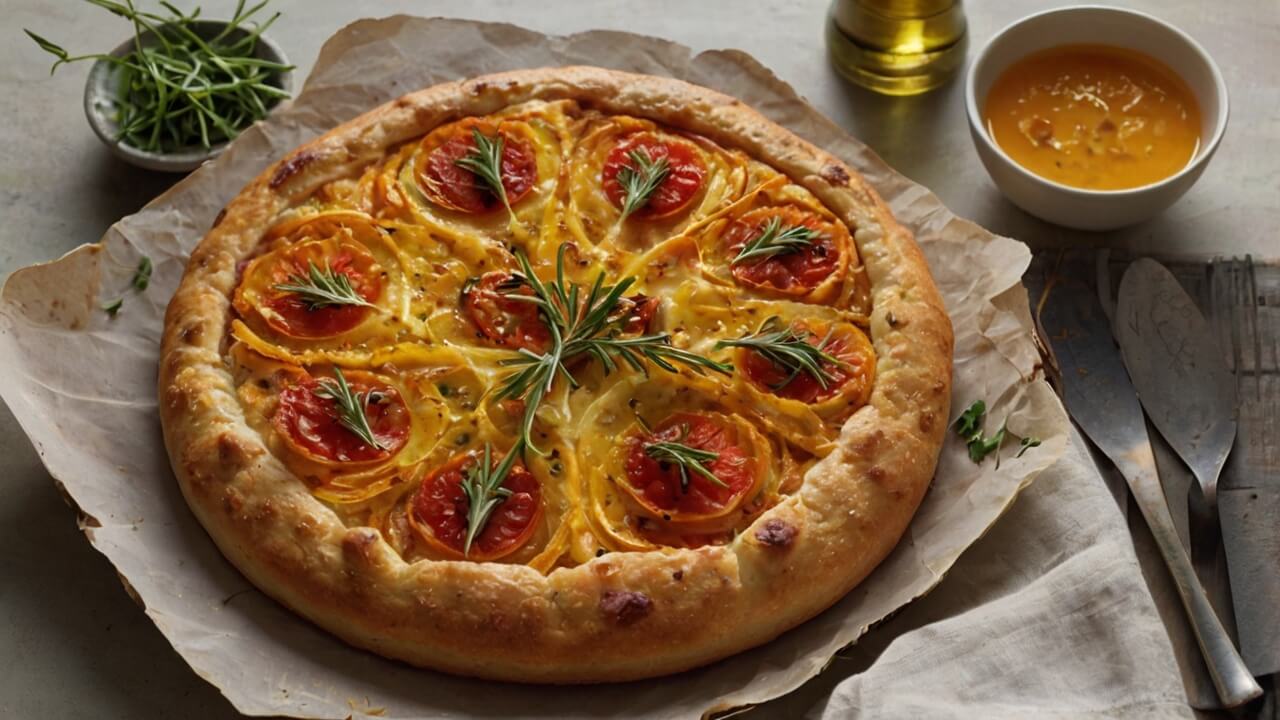
For Anne Burrell’s signature focaccia recipe, you’ll need the following ingredients:
- 1 cup warm water
- 1 package (2 1/4 teaspoons) active dry yeast
- 3 1/4 cups all-purpose flour, plus more for dusting
- 1 teaspoon salt
- 1/4 cup extra virgin olive oil, plus more for drizzling
To ensure the best results, it’s recommended to have these essential tools and equipment on hand:
| Tool | Description |
|---|---|
| Large mixing bowl | For combining and kneading the dough |
| Wooden spoon | For mixing the ingredients initially |
| Clean kitchen towel | For covering the dough during rising |
| Baking sheet or cast-iron skillet | For baking the focaccia |
| Pastry brush | For brushing the dough with olive oil |
Having the right ingredients measured accurately and the necessary tools at your disposal will set you up for success in creating Anne Burrell’s flavorful and crispy focaccia.
Step-by-Step Instructions for Anne Burrell’s Focaccia Recipe
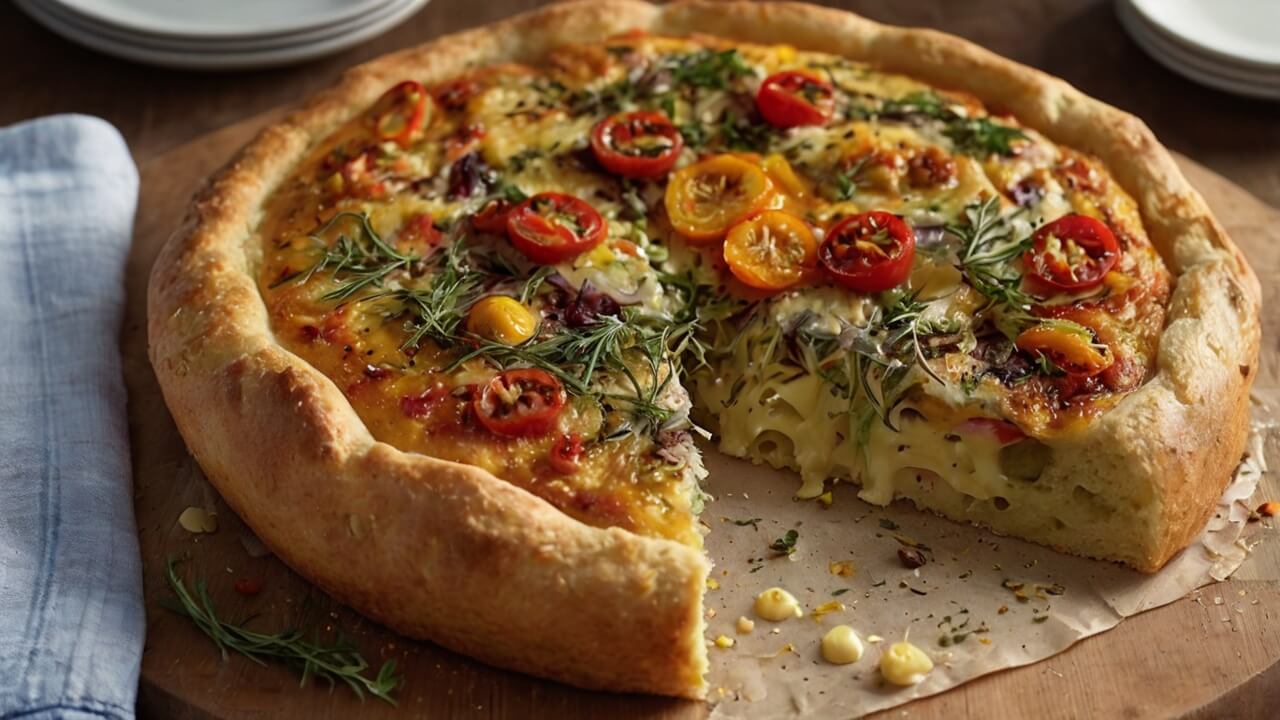
Begin by proofing the yeast. In a small bowl, combine the warm water and granulated sugar. Sprinkle the active dry yeast over the surface and let it sit for about 5-10 minutes until the mixture becomes foamy, indicating that the yeast is alive and active.
In a large mixing bowl, combine the all-purpose flour, salt, and olive oil. Create a well in the center and pour in the proofed yeast mixture. Using a wooden spoon or your hands, gradually incorporate the dry ingredients into the wet ingredients until a shaggy dough forms.
Turn the dough out onto a lightly floured surface and knead for about 8-10 minutes. The dough should become smooth, elastic, and slightly tacky to the touch. If it seems too dry, add a splash of warm water; if it’s too sticky, dust with a bit more flour.
Place the kneaded dough in a lightly greased bowl, cover with a damp towel or plastic wrap, and let it rise in a warm, draft-free area for about 1-1.5 hours, or until doubled in size.
Once the dough has risen, punch it down to release the air pockets. Transfer it to a rimmed baking sheet lined with parchment paper or generously greased with olive oil. Using your fingertips, dimple the dough and spread it out to fit the pan, creating a rustic, uneven surface.
Drizzle the top of the dough generously with extra-virgin olive oil, making sure to coat the dimples and crevices. Cover the pan loosely with a towel or plastic wrap and let the dough rise for another 30-45 minutes.
Preheat your oven to 425°F (220°C). Once the dough has risen for the second time, use your fingertips to create additional dimples in the surface, further enhancing the focaccia’s signature texture.
Bake the focaccia for 20-25 minutes, or until the top is golden brown and the bottom is crispy. Remove it from the oven and let it cool slightly on a wire rack before slicing and serving.
Achieving the Perfect Dough Texture
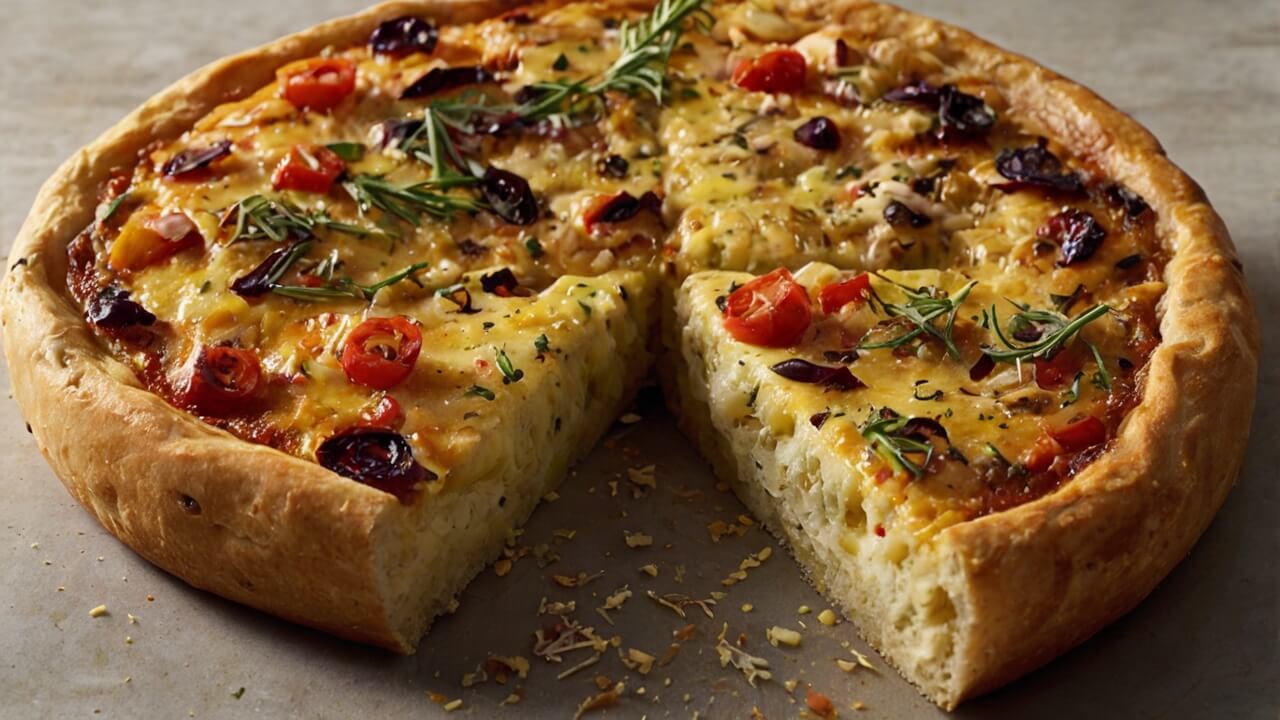
Achieving the perfect dough texture is crucial for creating a delicious and authentic focaccia. Anne Burrell’s recipe emphasizes the importance of allowing the dough to rise properly, resulting in a light and airy crumb with a crispy exterior. Here are some tips to ensure your dough rises correctly and achieves the desired texture:
Activating the Yeast: Before beginning the recipe, it’s essential to ensure your yeast is active and viable. To do this, combine the yeast with warm water and a pinch of sugar. After five to ten minutes, the mixture should become frothy and bubbly, indicating that the yeast is alive and ready to use.
Kneading Technique: Proper kneading is vital for developing the gluten structure in the dough, which contributes to its texture. Knead the dough for at least 10 minutes, using the heel of your hand to push and stretch the dough. This process helps create a smooth, elastic dough that will rise evenly.
Proofing Environment: The temperature and humidity of the proofing environment can significantly impact the dough’s rise. Anne Burrell recommends proofing the dough in a warm, draft-free area, such as an oven with the light on or a microwave with a cup of hot water. Maintain a temperature between 75°F and 85°F (24°C and 29°C) for optimal results.
Folding and Stretching: During the proofing process, gently fold and stretch the dough every 30 minutes to redistribute the yeast and encourage even rising. This technique also helps create the signature air pockets that give focaccia its unique texture.
Dimpling the Dough: Once the dough has risen and is transferred to the baking pan, use your fingertips to create deep dimples across the surface. This step not only gives the focaccia its distinctive appearance but also helps it cook evenly and develop a crispy crust.
By following these tips, you’ll be well on your way to achieving the perfect dough texture for Anne Burrell’s focaccia recipe. Remember, patience and attention to detail are key when working with yeast doughs, but the results are well worth the effort.
The Importance of Olive Oil
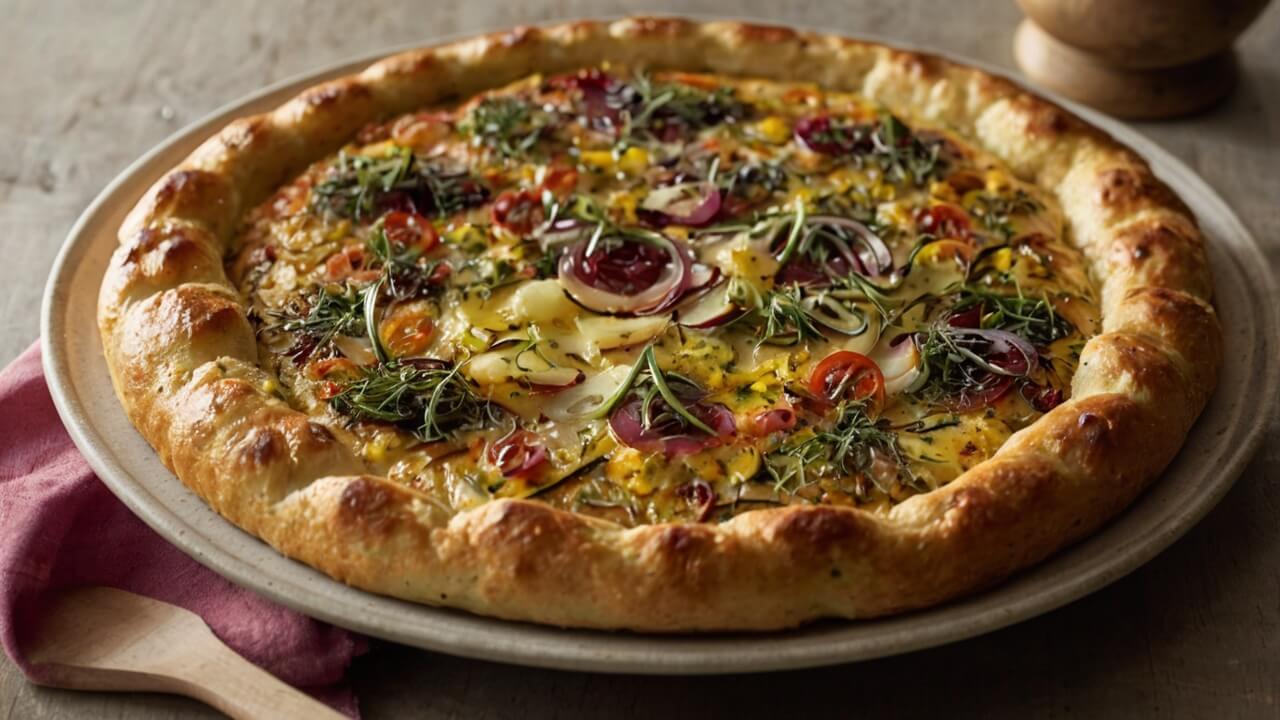
Anne Burrell’s focaccia recipe stands out for its generous use of high-quality olive oil, which plays a crucial role in achieving the bread’s signature crispy crust and rich, robust flavor.
Unlike some recipes that treat olive oil as an afterthought, Burrell’s approach celebrates this ingredient as a star player. The liberal application of olive oil begins even before the dough is formed.
A generous amount is poured into the bottom of the baking pan, creating a luxurious pool for the dough to rest in as it rises. This initial bath of olive oil infuses the bread with its distinct aroma and taste from the very beginning.
As the dough proves and bakes, the olive oil seeps into every nook and cranny, imparting its fruity notes and contributing to the bread’s tender interior.
However, it’s the crust where the olive oil truly shines. During baking, the oil on the surface of the dough crisps up, creating a delightfully crunchy and golden-brown exterior that shatters with each bite.
Burrell’s focaccia recipe calls for a high-quality extra-virgin olive oil, as its robust flavor and aroma can withstand the high heat of the oven without becoming bitter or rancid.
The choice of olive oil can significantly impact the final taste, so it’s worth splurging on a good-quality bottle from a reputable producer.
Variations and Toppings
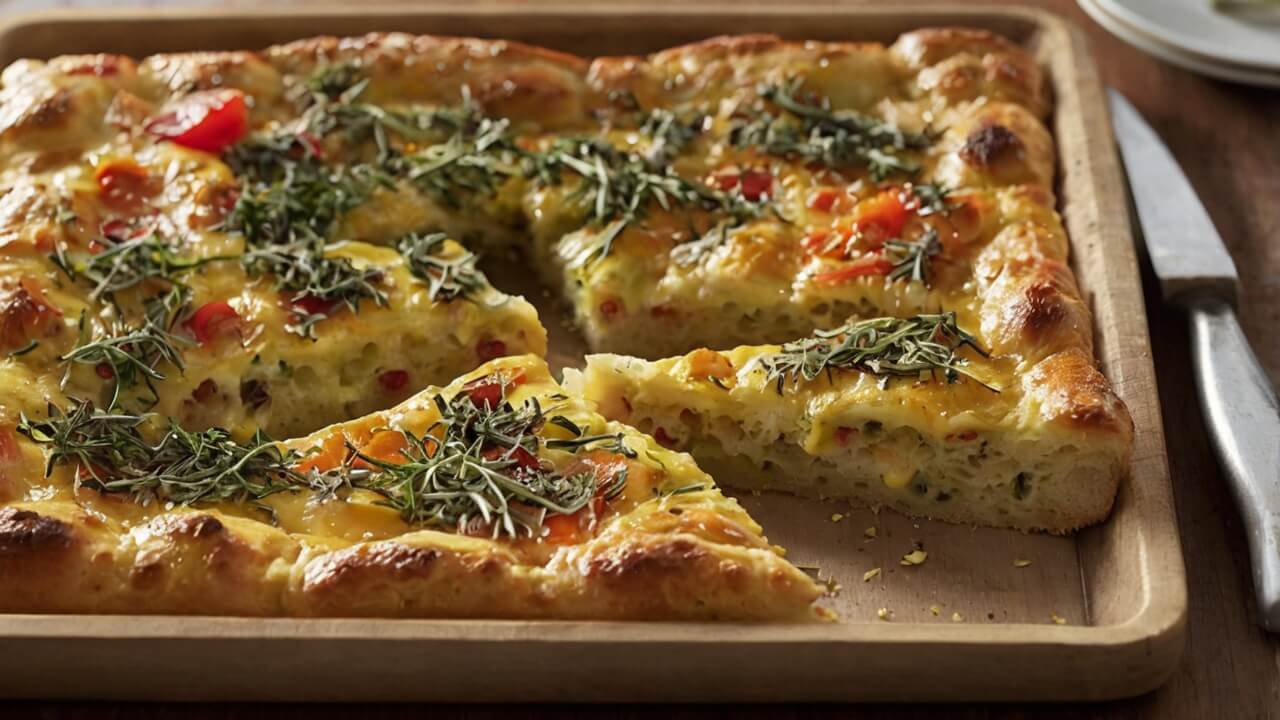
Anne Burrell’s focaccia recipe is incredibly versatile, allowing you to customize it according to your taste preferences.
One way to add a burst of flavor is by incorporating herbs and spices into the dough or as toppings. Some delicious options include:
- Rosemary and Sea Salt: Sprinkle fresh or dried rosemary over the top of the focaccia before baking, and finish with a generous sprinkling of coarse sea salt for a classic Italian flavor combination.
- Garlic and Parmesan: Finely chop fresh garlic and mix it into the dough, or rub a halved garlic clove over the surface of the baked focaccia. Grate Parmesan cheese over the top for a savory, umami-rich treat.
- Sun-Dried Tomatoes and Basil: Incorporate sun-dried tomatoes into the dough or as a topping, paired with fresh basil leaves for a burst of Mediterranean flavor.
- Caramelized Onions and Thyme: Sauté thinly sliced onions until they’re deeply caramelized, and then sprinkle them over the focaccia along with fresh or dried thyme.
- Olives and Feta: Stud the focaccia with briny olives (such as Kalamata or green olives) and crumbled feta cheese for a salty, tangy twist.
Additionally, you can experiment with various seeds, such as sesame, poppy, or fennel, to add texture and nutty flavors to your focaccia. Don’t be afraid to get creative and combine different herbs, spices, and toppings to create your own unique flavor profile.
Common Mistakes to Avoid
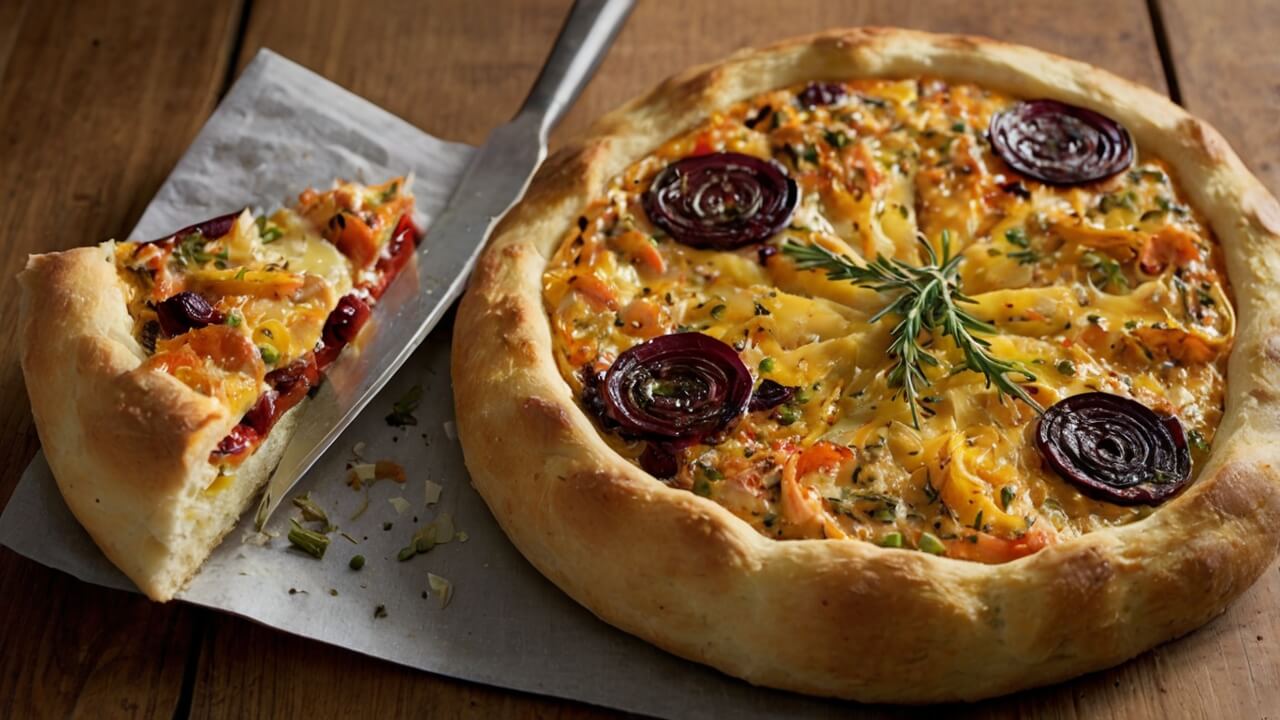
One of the biggest pitfalls when making focaccia is not allowing enough time for the dough to rise. Yeast needs a warm environment and ample time to activate and make the dough light and airy. Be patient and avoid rushing this crucial step.
Another common mistake is overworking the dough. While kneading is essential, too much kneading can cause the gluten strands to toughen, resulting in a dense and chewy focaccia. Knead the dough gently and only until it becomes smooth and elastic.
Improper proofing can also lead to disappointing results. Ensure the proofing environment is warm (around 75-85°F) and draft-free. Covering the dough with a damp cloth can help prevent it from drying out during this stage.
When it comes to baking, not preheating the oven properly is a common mistake. Focaccia requires a hot oven to achieve that signature crispy crust. Preheat your oven for at least 30 minutes before baking.
Lastly, not using enough olive oil can result in a dry and lackluster focaccia. Anne Burrell’s recipe calls for a generous amount of olive oil, which not only adds flavor but also contributes to the bread’s signature crispy exterior and tender interior.
If your focaccia doesn’t rise as expected, check the expiration date of your yeast and ensure the water temperature was within the recommended range (105-115°F). Too hot or too cold water can kill or hinder the yeast’s activity.
Serving and Pairing Suggestions
Once your focaccia is out of the oven, the aroma of freshly baked bread will fill your kitchen, making it hard to resist digging in right away. This versatile Italian bread can be served in a variety of ways, both as an appetizer or a side dish.
For a classic Italian experience, consider serving the focaccia alongside a flavorful olive oil and balsamic vinegar dipping sauce. The crispy crust and soft interior make it perfect for soaking up the rich flavors.
Alternatively, you can pair it with a variety of spreads or dips, such as roasted red pepper hummus, pesto, or a simple tomato bruschetta topping.
If you’re looking for a heartier meal, the focaccia can be used as a base for sandwiches or panini. Try filling it with slices of prosciutto, fresh mozzarella, and basil for an Italian-inspired lunch or dinner. You can also serve it alongside a hearty soup or stew, using the bread to soak up the delicious broths and flavors.
Leftovers can be stored in an airtight container or bread box for up to three days. To revive the crispness of the crust, simply place the focaccia in a preheated oven or toaster oven for a few minutes before serving.
You can also repurpose leftover focaccia by turning it into croutons for salads or breadcrumbs for coating dishes like chicken or eggplant parmesan.
Expert Tips from Anne Burrell
“The key to getting that perfect crispy crust is using high-quality olive oil and not being shy with it. You really want to drizzle it generously over the dough before baking.”
Anne Burrell emphasizes the importance of olive oil in achieving the signature texture of her focaccia. She recommends using a high-quality extra virgin olive oil and being liberal with the amount used, as it contributes to the crispy, golden crust.
“Don’t be afraid to let the dough rise for longer than you think it needs. That extra time allows the yeast to work its magic and creates those beautiful air pockets in the bread.”
According to Burrell, patience is crucial when it comes to letting the dough rise properly. She advises letting the dough rise for an extended period, even longer than the recipe specifies, to ensure those coveted air pockets and a light, airy texture.
“Focaccia is all about the toppings, so get creative! Fresh herbs, roasted garlic, olives, sun-dried tomatoes – the possibilities are endless. Just make sure to press them into the dough before baking.”
While the base recipe is delicious on its own, Burrell encourages home bakers to experiment with toppings to add their personal touch. She suggests using fresh herbs, roasted garlic, olives, or sun-dried tomatoes, pressing them gently into the dough before baking to ensure they adhere and infuse their flavors.
Home Baker Testimonials
“I’ve been an avid follower of Anne Burrell’s cooking shows, and her focaccia recipe is a game-changer! The generous use of olive oil gives the bread an incredible flavor and crispy crust that’s out of this world. I followed the instructions carefully, and the dough rose beautifully. My family couldn’t get enough of the warm, aromatic focaccia straight from the oven.” – Sarah, Boston, MA
“As a beginner baker, I was a bit intimidated by the idea of making focaccia from scratch. However, Anne Burrell’s recipe is so well-explained and easy to follow that I nailed it on my first try! The step-by-step instructions and expert tips were invaluable. My focaccia turned out perfectly golden and fluffy, with a delightful olive oil flavor. I can’t wait to experiment with different toppings next time.” – Michael, Los Angeles, CA
“I’ve tried countless focaccia recipes over the years, but Anne Burrell’s version is hands-down the best. The dough is incredibly light and airy, yet still has that signature crispy crust. The secret is definitely the generous amount of olive oil used throughout the process. I love how versatile this recipe is – I’ve made it with rosemary, sun-dried tomatoes, and even caramelized onions. It’s a crowd-pleaser every time!” – Emily, Chicago, IL
Conclusion
Anne Burrell’s focaccia recipe is a true testament to her culinary expertise and passion for Italian cuisine. This crispy, olive oil-infused bread is a delightful addition to any meal or a satisfying snack on its own.
With its unique blend of ingredients and the careful attention to detail in the baking process, this focaccia is sure to impress even the most discerning of palates.
We encourage you to gather your ingredients, roll up your sleeves, and embark on this delicious baking adventure.
Follow the step-by-step instructions, heed the expert tips, and savor the aroma of freshly baked focaccia wafting through your kitchen. Don’t be afraid to experiment with variations and toppings to make the recipe your own.
Once you’ve achieved the perfect golden-brown crust and pillowy interior, take a moment to appreciate your handiwork. Share your focaccia masterpiece with friends and family, or indulge in a slice (or two) while it’s still warm from the oven.
We invite you to share your baking experience on social media, tagging us with #AnneBurrellFocaccia, and inspire others to try this remarkable recipe.
Subscribe to our newsletter to receive more culinary inspiration, tips, and updates from the world of home baking.
Embrace the joy of creating delectable bread with Anne Burrell’s guidance, and let this focaccia recipe become a cherished addition to your culinary repertoire.

